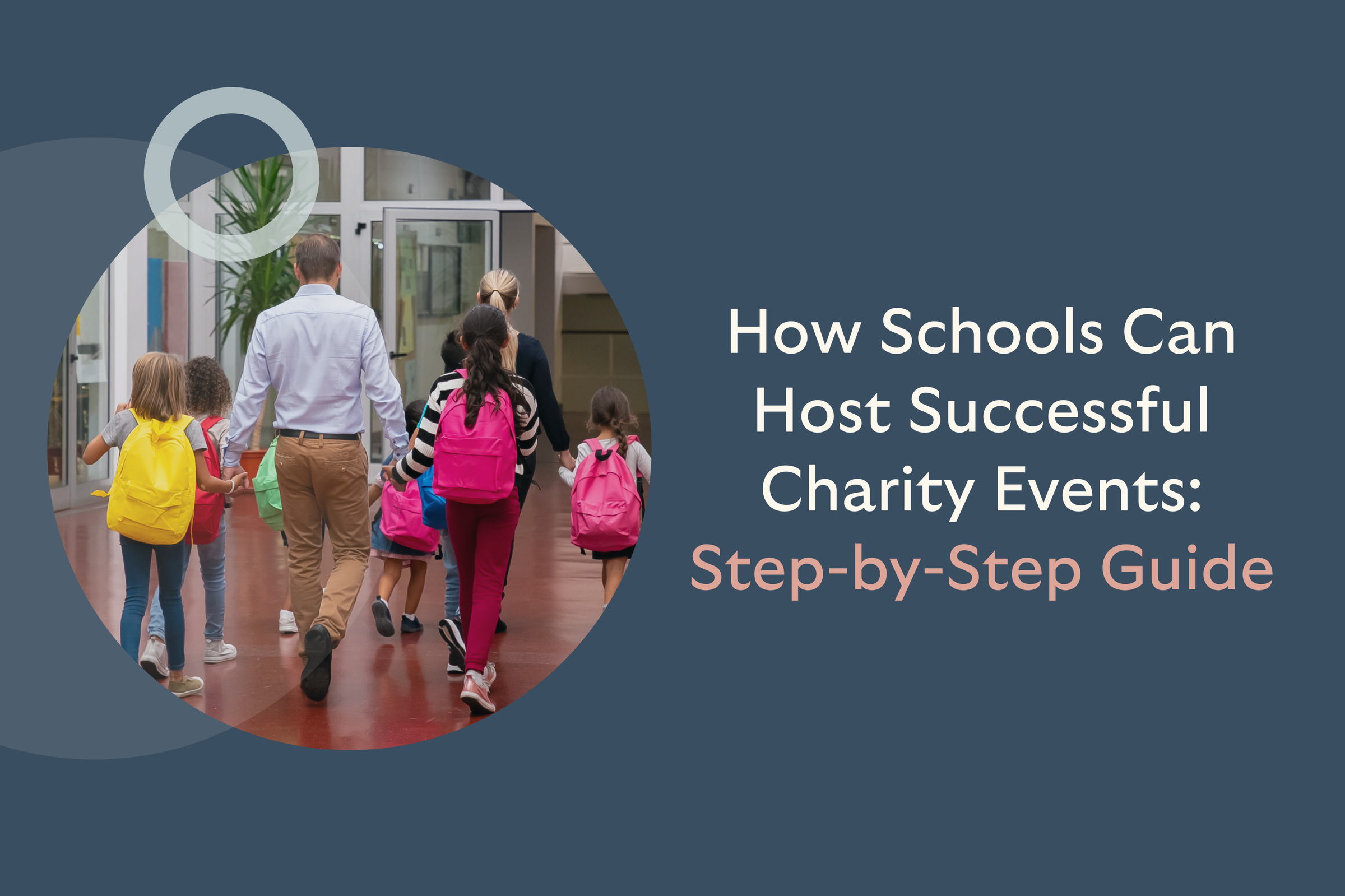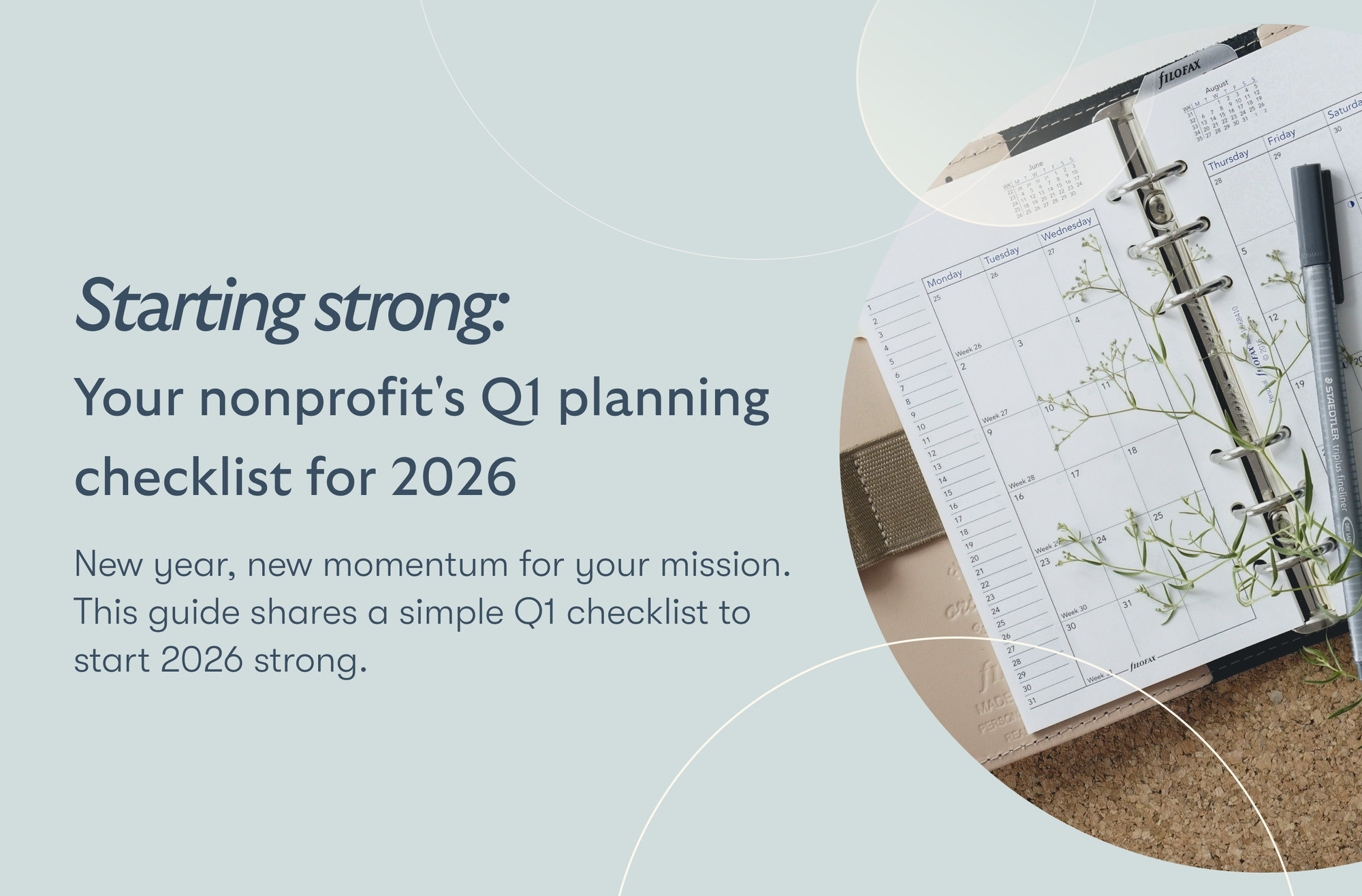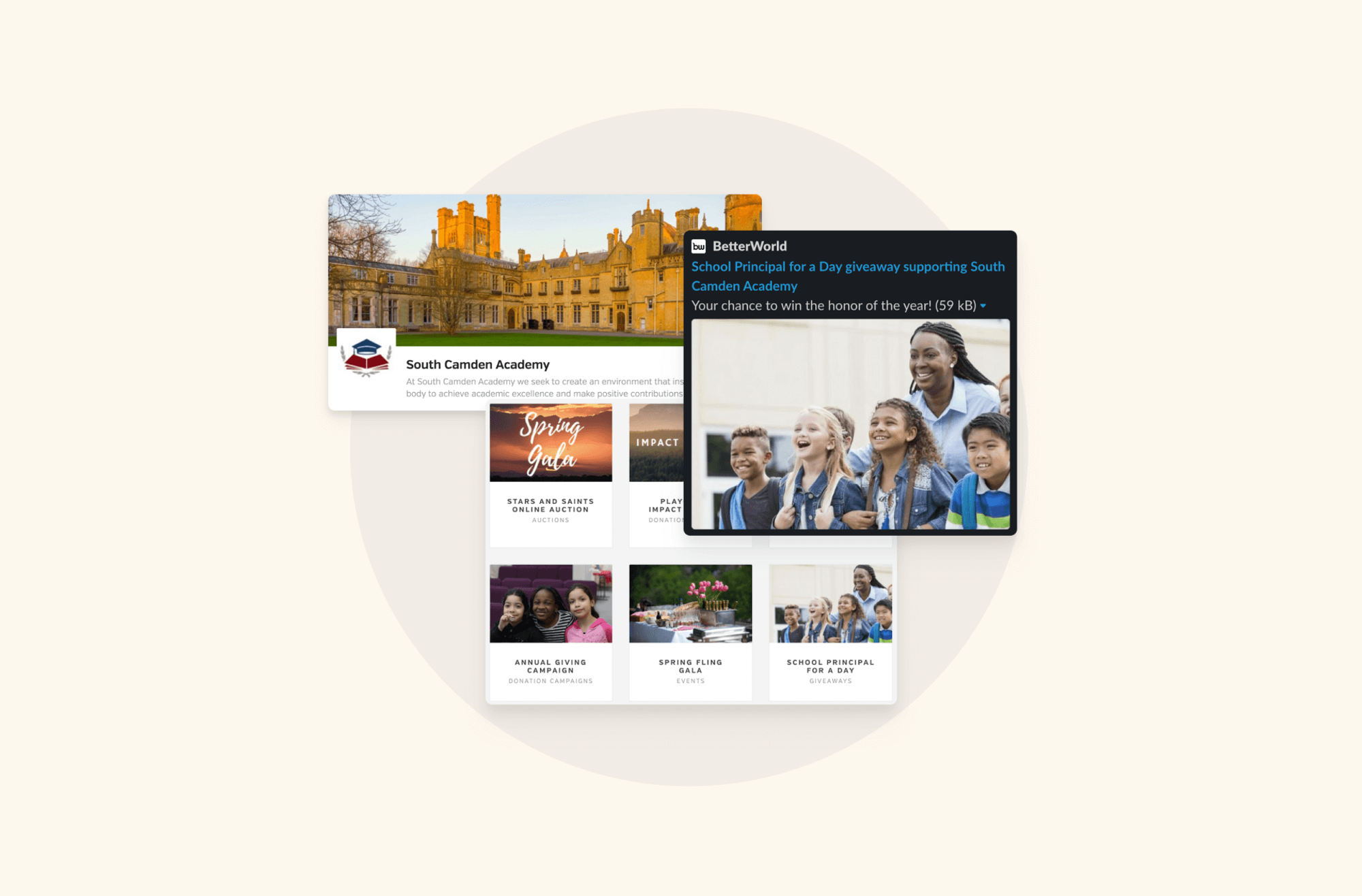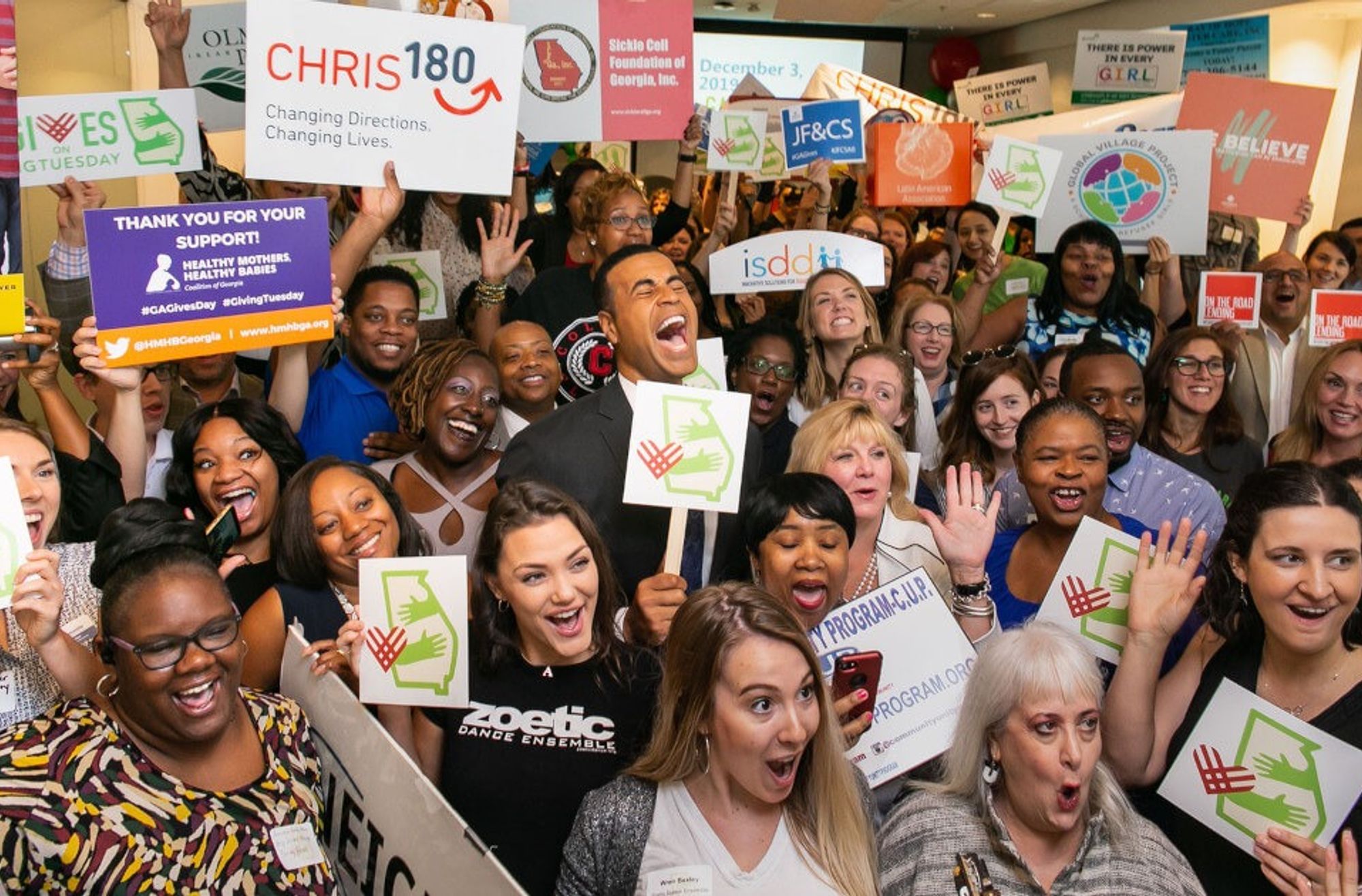Mobile Check-In — easily track and check in donors into any event from any device
Keep your bidders coming back with optional outbid notifications via text
Raise additional funds for your event by displaying sponsors on your online pages
Downloadable table cards with short-links & QR codes to make it easy to bid
Hosting a Successful Charity Event: Step-by-Step Guide
By Colin Hunter

Did you know that 35% of schools only raise between $0 and $5,000 each year from fundraising, while 27.1% manage to earn over $75,000? Hosting a charity event can make a big difference in which side of that statistic your school lands on.
But organizing these events takes careful planning. You might be wondering where to start or how to make sure your event is successful.
This guide will take you through each step of hosting a charity event at your school, making it easy for you to raise the funds you need and support causes you care about.
Step 1: Choose a Cause or Need
Before jumping into planning, take a moment to ask, “Why are you doing this?” Picking a cause or need gives your event purpose and helps people feel connected to it.
It could be something close to your school, like new classroom supplies, a student emergency fund, or support for scholarships.
The cause you choose can make or break your turnout. People want to feel like their time and donations matter.
In fact, nearly half (44%) of donors give to charities related to causes they have personally experienced or care deeply about. So, if your school picks something your community already supports or relates to, you’ll likely see more people get involved.
Try talking to students, parents, and staff to learn what matters to them. Is there a local issue that keeps recurring, or is something at school in need of attention?
Picking a cause together helps everyone feel like they’re part of something.
When you're hosting a charity event for your school, starting with the right cause helps guide all your next steps—from what kind of event to host to how you ask for support.
Step 2: Set a Goal
Once your school picks a cause, the next step is to set a clear goal. This gives your event direction and helps everyone stay on track.
Think about what you're trying to achieve. Is it raising $5,000 for new sports equipment? Or maybe getting 100 people to attend a family night to raise money for student programs?
When you're hosting a school event, goals give people something to work toward. They also make it easier to plan your budget, promote the event, and track its progress. Without a goal, it’s hard to tell if your school fundraising event is actually making a difference.
Setting goals works best when they are specific and realistic.
A goal like “raise money for school” is too broad. But saying “raise $2,000 to upgrade the science lab” gives everyone a clear picture. The same goes for participation goals.
You might aim to get 50 students involved or 20 volunteers to help out.
Goals also help your supporters connect with the cause. If they know what you're aiming for and why, they’re more likely to help.
So, before going further with your school charity event ideas, write down what success looks like. Keep it simple, make it realistic, and share it with everyone involved.
Check out 15 Best Fundraising Platforms for Schools.
Step 3: Form an Event Committee
You don’t have to plan everything on your own. Putting together a small team can help make your school fundraising event run smoother.
A good mix of teachers, parents, and student leaders works best. Everyone brings something different to the table—whether it’s experience, ideas, or extra hands.
Start by asking people who are already involved with the school. Parents who help with the PTA, teachers who run clubs, and students who want to build leadership skills can all be great choices. Just make sure everyone understands their part.
To keep things organized, it helps to give each person a clear role:
- Event Coordinator – Oversees everything and makes sure tasks get done
- Treasurer – Handles the money and keeps track of funds
- Marketing Lead – Spreads the word through flyers, emails, or social media
- Volunteer Coordinator – Finds and organizes helpers for the day of the event
A strong team makes a big difference, especially when you’re hosting a charity event that involves lots of moving parts. Set up regular meetings, even if they're short, to check in and share updates. That way, no one feels out of the loop.
Step 4: Choose the Right Type of Charity Event
Many types of events work well for schools. Each one has its own vibe, so picking the right one depends on your goals and who you’re inviting.
Here are a few common school charity event ideas:
- Auctions – Live or silent auctions with donated items from families or local businesses
- Bake Sales – Homemade cookies, cupcakes, and other treats sold during school hours or events
- Walkathons – Students collect pledges and walk laps around the track or schoolyard
- Talent Shows – Students and staff perform for an audience, with ticket sales going to the cause
- Carnivals or Game Nights – Small games, prizes, and snacks make it fun for the whole family
Choosing the right event starts with looking at your school community. Think about what people enjoy and what will get them involved. A walkathon might be great for younger kids with active parents, while a talent show could work better for middle or high school students.
Also, think about how much money you’re hoping to raise. A bake sale might bring in a few hundred dollars, while an auction could bring in more if the items are valuable.
Still not sure? Read our guide, Which Type of Fundraising Event Is Best For You?
Try to match your idea to both your audience and your goal. That way, your school fundraising event will be more likely to reach the right people and bring in the support you need.
Raise Funds for Free with BetterWorld’s Modern Fundraising Tools. Start raising money within 5 minutes. Sign up now and get all the solutions in one place.
Step 5: Plan Your Budget
Before you start spending money on flyers or booking a space, it’s a good idea to build a simple budget. It doesn’t have to be fancy, but it should list everything you might spend money on. This helps you see if the event will generate more revenue than it costs.
Start by writing down all possible expenses. That could include supplies, decorations, printing costs, permits, or snacks.
Then, think about how much money you expect to raise from the school fundraising event. The goal is to ensure you don’t end up spending more than you earn.
Balancing the budget is important. You want the event to be fun and well-organized, but the money raised should go to the cause—not just to cover event costs.
Here are a few ways to manage your expenses:
- Ask local businesses to donate supplies or sponsor a part of the event
- Use school space instead of renting a venue
- Get volunteers to help instead of hiring extra staff
- Shop around for the best prices on items like food and decorations
- Track every dollar so there are no surprises later
Hosting a charity event should help your cause, not create more stress or financial pressure.
Step 6: Pick a Suitable Date and Venue
The date and place you choose can really shape how your school fundraising event turns out. A good date means more people can attend. A good venue keeps things running smoothly.
Start by checking your school calendar. Avoid planning during exam weeks, major school breaks, or other community events that might pull families in different directions.
Early fall and late spring are usually good times. The weather is nice, and school activities are not too packed.
The end of the school year also works well—families may want to come together to wrap up the year and support a cause at the same time.
For the venue, think about what fits your event and what’s easy for families. You don’t need to rent an expensive space. Most schools already have places that work just fine. Here are a few options:
- School Gymnasium – Good for auctions, talent shows, and indoor games
- Outdoor Spaces – Great for walkathons, carnivals, or picnics when the weather’s nice
- Local Community Centers – Useful if you expect a large crowd or need extra space
When hosting a charity event, picking the right time and place helps everyone feel welcome and ready to join in. The easier it is to show up, the better your chance of meeting your goals.
Host your next school charity event with our Easy Fundraising Software For In-Person Events. Sell tickets, register guests and much more for zero cost.
Request a demo today to find out more.
Step 7: Secure Sponsorships and Partnerships
Getting help from local businesses and groups can make your school fundraising event easier to run and more successful. Sponsors can donate money, supplies, or services.
In return, they get a chance to support the community and get their name out there.
Start by making a list of local places—restaurants, shops, banks, or even small business owners connected to your school. Reach out with a short, clear message.
Let them know what the event is for, how it helps the school, and how they can be part of it.
It helps to create a simple sponsorship package. This gives businesses options for supporting the event and shows what they get in return. You can offer things like:
- Their logo on flyers or event signs
- A thank-you post on your school’s social media
- A booth or table at the event
- A spot in your event program or newsletter
Be honest about what your school can offer. Keep it simple, and make sure they know how their help makes a difference.
If you’re hosting a school event, partnerships can help cover costs and bring in more people. Local support goes a long way when the whole community feels part of it.
In-person events and galas made easy!
Step 8: Promote the Event Effectively
Planning is only half the job. Getting people to show up is just as important. A good charity event-planning process includes smart promotion. That means spreading the word in more than one place and doing it more than once.
Start by using the channels your school already has in place. Post the event details on the school website and in the newsletter.
Share updates on social media like Facebook and Instagram. Put up posters in the hallways, office, and community centers. If there’s a local newspaper, send in a short press release or event listing. These simple tools can go a long way.
Now, about the message. Don’t just say “Join us!” Give people a reason. Try short, clear content that shares what the event supports. For example, “Help us raise money for new library books” works better than just naming the event.
Add a photo if you can, and always include the date, time, and location. If it’s one of your virtual charity events, remind folks they can join from anywhere.
One reminder isn’t enough. People forget. Plan a schedule to post or send messages more than once. A reminder the week before and the day before helps a lot.
Here’s something to keep in mind: 32% of donors say they’re most inspired to give through social media. Email comes close at 30%, followed by websites at 17%, print at 15%, TV or radio ads at 3%, phone calls at 2%, and text messages at 1%.
Every promoting channel has its importance because people give in different ways. You can’t rely on just one method.
Step 9: Recruit and Train Volunteers
No school fundraising event runs smoothly without helping hands. Volunteers make it all possible—from setting up tables to running games and cleaning up after.
That’s why the next part of hosting a school event is finding and preparing the right people.
Start by asking your school community. Students, parents, teachers, and even local neighbors are often happy to help, but they may need a little encouragement.
Post a simple sign-up form online or hang a volunteer board in the main office. Let people know what kind of help is needed and how much time it will take. That makes it easier for them to say yes.
Once people sign up, don’t leave them guessing. Give each volunteer a clear role. For example, someone can handle registration, someone else can help with setup, and a group can work the food table or prize station.
If you’re planning multiple activities, like games or auctions, you’ll need a lead person for each one.
Training doesn’t need to be long or formal. It can be a quick meeting before the event to go over the basics: what to expect, who to talk to if there's a problem, and what time they need to arrive. You can also send out a short guide with simple instructions.
Keep things organized during the event by assigning one main person to check in with volunteers and answer questions. That way, everyone knows where to go and what to do.
Step 10: Event Day Preparation
The big day is here. But before the first guest walks in, there’s still a bit of work to do. Being prepared makes a huge difference, especially when you’re hosting a school event.
Here’s a simple checklist to help you stay on track.
Checklist for the Day Before the Event:
- Confirm the volunteer list and remind them of their roles
- Double-check the event supplies (tables, signs, decorations, food, prizes)
- Walk through the setup plan with your team
- Print or prepare any needed signs, tickets, or programs
- Charge phones, tablets, or other devices being used
- Make sure a first aid kit is available
- Review your detailed schedule one more time
Checklist for the Day of the Event:
- Arrive early with a printed copy of the schedule
- Set up tables, booths, and signs as planned
- Check in with volunteers and answer questions
- Do a quick test if you’re using sound systems or tech
- Set up a central spot where people can ask for help
- Keep snacks or water nearby for volunteers
- Make sure donation or ticket areas are ready
Tips for Setup and Coordination:
- Assign one person to handle setup and one for cleanup
- Use name tags or colored shirts for volunteers so they’re easy to spot
- Keep a copy of the volunteer list and roles handy
- Be ready for small changes—weather, delays, or missing supplies
- Keep calm and solve one problem at a time
Hosting a school event works best with a detailed schedule. Write it out and share it with your team the day before. Include setup time, activity start and end times, and who’s in charge of what.
Try the school fundraising the easy way with our dedicated Software For School Fundraising.
No matter who you're reaching out to, BetterWorld offers tools that fit your school fundraising campaign.
Step 11: Host and Manage the Event Successfully
Now that everything is set, it’s time to run the event. Hosting a charity event is about creating a good experience for everyone who attends.
Start by welcoming your guests. A simple smile and greeting at the entrance can set the right tone. Let people know where to go and how to join in on activities.
Keep things moving by following your schedule, but don’t stress if things shift a little. Being flexible helps.
If you're running fundraising activities like games, auctions, or raffles, make sure someone is in charge of each one. They should know the rules, how to collect money, and how to answer questions.
Keep a small team ready to step in if a table needs help or if something isn’t working right.
To keep the mood positive, check in with volunteers and attendees now and then. A quick thank-you or small talk can go a long way. If kids are part of the event, try to keep things light and fun with music or a few simple games.
Don’t forget to take photos and short videos during the event. You’ll want to capture the happy moments, like kids enjoying activities or a parent winning a prize. These can help later when you plan your next school fundraising event or want to share highlights with families and the school community.
Step 12: Follow-Up and Show Gratitude
After the event is over and the last table is packed up, don’t forget one of the most important parts—saying thank you. Everyone who helped out, donated, or just showed up played a role in making your school fundraising event a success.
A simple thank you goes a long way.
Take a moment to thank sponsors, volunteers, staff, students, and families. It helps build good relationships and encourages people to support your next event too.
Here are some easy ways to show your thanks:
- Send handwritten or printed thank-you notes to sponsors and volunteers
- Post shout-outs on the school’s social media pages (With permission)
- Include names or groups in the next school newsletter (With permission)
- Share group photos from the event with short thank-you messages
- Create a thank-you board at school with pictures and notes (With permission)
It also helps to share the results of your fundraising. Let people know how much was raised and what the money will be used for. For example, if the funds went toward art supplies or sports uniforms, post a few pictures showing those things in use.
Sharing success stories and updates gives people a clear view of the impact. It makes them feel part of something good and keeps them interested in future school charity event ideas.
Step 13: Evaluate and Improve for Future Events
After everything is wrapped up, take a little time to look back. Hosting a school event gives you a chance to learn what went well and what could be better next time. This step helps make future events smoother and more enjoyable for everyone involved.
Start by asking a few simple questions:
Did the event meet your goal?
Were people happy and engaged?
Did anything not go as planned?
One of the best ways to get answers is by asking those who were part of it. You can gather feedback from volunteers, students, staff, and even attendees.
Here are a few ways to do that:
- Send out a short online survey with a few questions
- Ask for comments through email or class newsletters
- Hold a quick meeting with your volunteer team to hear their thoughts
- Invite teachers or staff to share what they noticed during the event
Write down what you learn. Keep notes about what worked well—like popular activities or strong volunteer support—and also the things that need more planning. Maybe the setup took longer than expected, or you needed more signs.
These notes will come in handy the next time you’re hosting a charity event. You won’t have to start from scratch, and you’ll have a better idea of what to expect.
Small changes based on what you learn now can lead to even better events in the future.
FAQs
1. How long should a school charity event last?
Most events work well within 2 to 4 hours. It depends on the type of activities planned.
2. What are some easy fundraising activities for younger students?
Try simple games, art stations, or a read-a-thon. Keep it short and fun.
3. Can we charge an entry fee for the event?
Yes, as long as it’s affordable. You can also suggest a donation instead of a set fee.
4. How far in advance should we start planning?
Start planning at least 3 to 6 months before the event date.
5. Do we need any special permits to host a school event?
It depends on your location and activities. You may need insurance, too. Check with the school office or local city rules.
6. What’s a good day to hold a school fundraiser?
Friday evenings or weekend afternoons usually work best for families.
7. Can we include food at the event?
Yes, but check for food safety guidelines and any allergy concerns ahead of time.

Join 105,000+ amazing nonprofits, organizations, and fundraisers on BetterWorld

Let our FREE fundraising tools help you raise more funds with less effort








